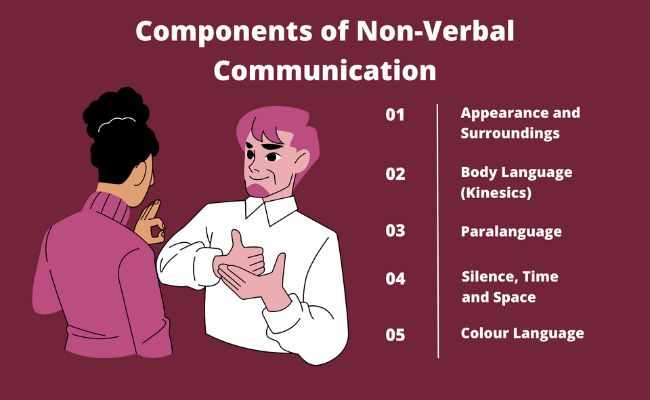


You want to know what non-verbal communication is. Here is what we are going to do about it. Communication is of two types, verbal and non-verbal. Communication without the use of words is called non-verbal communication. On the contrary verbal communication involves words.
Sometimes a verbal message contradicts a non-verbal message. Words are relatively easy to control but body language, facial expressions, and vocal aspects are not. Almost 60 to 90 per cent effect of a message comes from non-verbal cues.
Non-verbal communication becomes complete with the help of the following components.
Appearance and surroundings are important factors in non-verbal communication. Appearance conveys non-verbal impressions. which influences the attitude. reaction, and the response of the receiver.
The format, neatness and language of a written message send a nonverbal message to the reader. He will come to know things about your message even before he reads it.
The success of a message depends upon suitable personal appearance as well as the appearance of the surroundings.
Our personal appearance conveys non-verbal messages to the people and enhances the effect of the spoken words. Our dress hairstyle, jewellery, cosmetics, posture, etc. form our personal appearance. These things tell about our habits, profession age, social status, and nationality, etc.
Surroundings vary according to culture, status, and country. Aspects of surroundings include room size, location, furnishings, and decoration.
Body language includes facial expressions, gestures, postures and movements, smell and touch and paralanguage (voice and other sounds)
The eyes and face are important means of nonverbal communication. They can reveal hidden emotions including anger, fear, joy, passion, confusion, etc.
Postures gestures and body movements carry non-verbal messages. Gestures and movements are different in every culture. The meaning of a gesture in one culture may be different in another.
Various odors and fragrances convey the emotions of the sender. These can also affect the attitude of the receiver especially if he is sensitive to scents. Similarly, touching people can communicate friendship, love approval, hatred, anger, or other feelings.
Your voice quality and extra sounds are a part of nonverbal communication. These are called paralanguage. Paralanguage also includes volume, rate, pitch, and other sounds, such as throat clearing and sighing, etc.
Principles of Business Communication for Effective Communication
Silence time and space can also convey a nonverbal message effectively.
Silence apparently seems unimportant and meaningless yet, sometimes it becomes more meaningful than words. For example, you write a collection letter to a defaulting customer requesting him to clear his outstanding account by a certain date. If you receive no reply by that date, what will be your reaction to the silence; certainly it would arise many questions in your mind.
Time language conveys much non-verbally. Concepts of time vary across cultures. Americans and Germans, for example, are quite punctual. Middle Eastern business people think little of arriving after an agreed-upon time. If you arrive on time for a meeting in Portugal, your host might wonder why you came so early.
The meaning we give to the space around us is known as proxemics or space language. The idea of space also carries a non-verbal message. In different cultures, people like to keep a certain distance from one another. In the United States, space in a two-person conversation is about 18 inches. The need for space is less in many Middle Eastern counties and more in Denmark or Norway.
The meaning we give to the colors is known as color language. Different colors show different moods.
Finally, we can say that communication without words is known as nonverbal communication. Contradictory messages can be sent both verbally and nonverbally. Nonverbal communication has three main parts: 1. Appearance ii) Body Language; iii) Silence; and iv) space and time. Personal Look: Our outward appearance sends a nonverbal message to others and strengthens the impact of our spoken remarks.
Environment: Environment varies by culture, rank, and nation. Facial expressions, gestures, postures, movement, smell, touch, and paralanguage are all examples of body language. Gestures and facial expressions Silence, Time, Space, Postures and Movement, Smell, and Touch.
Importance of Business Correspondence Vital to Build Relationships
2 thoughts on “Components of Non-Verbal Communication which Make it Effective”